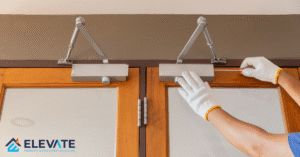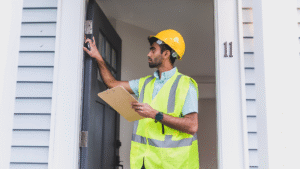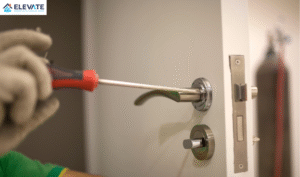Fire risk assessments are vital for ensuring the safety of students, staff, and visitors in schools and educational institutions. With the potential for large numbers of people in one location, and the diversity of building types, fire hazards can vary significantly. Conducting a fire risk assessment is a requirement under the Regulatory Reform (Fire Safety) Order 2005 and is essential for creating a safe learning environment.
Key Fire Risks in Schools and Educational Institutions:
- Overcrowded Corridors and Classrooms:
High numbers of students in confined spaces can obstruct evacuation routes, creating risks during a fire emergency. - Electrical Hazards:
Faulty wiring, overloading circuits, and the use of extension cords can lead to electrical fires. - Flammable Materials:
Schools often have art rooms, science labs, kitchens, and storage areas filled with chemicals, paints, and other combustible materials. - Cooking and Kitchen Areas:
Kitchens in schools are at risk of fire from cooking equipment, oil-based fires, and grease buildup. - Inadequate Fire Doors and Escape Routes:
Fire doors, exits, and escape routes must be clearly marked, accessible, and free of obstructions to ensure safe evacuation. - Flammable Decorations:
Bulletin boards, paper displays, and other decorative items in classrooms or hallways can increase the fire load. - Storage and Supply Rooms:
Schools may store chemicals, cleaning supplies, or paper products that are highly flammable.
Why Fire Risk Assessments are Crucial for Schools:
- Compliance with the Law:
The Regulatory Reform (Fire Safety) Order 2005 requires that fire risk assessments be carried out in all non-domestic premises, including educational institutions. Failure to comply with these regulations can result in legal consequences, fines, and potential liability in the event of a fire. - Protecting Lives:
The primary purpose of a fire risk assessment is to identify potential hazards and ensure that adequate measures are in place to protect students, staff, and visitors in the event of a fire. Proper fire safety can save lives by preventing fires or mitigating their impact. - Identifying Specific Risks:
Each educational institution has unique fire risks based on its building structure, layout, and activities. A tailored fire risk assessment identifies these risks and provides actionable steps to address them. - Providing Safe Evacuation Plans:
A fire risk assessment helps develop and review evacuation plans, ensuring that everyone knows the routes to safety. It also ensures that fire doors and emergency exits are functional and accessible. - Staff and Student Awareness:
Regular fire risk assessments help train staff and raise awareness among students about fire safety procedures and evacuation protocols.
Components of a Fire Risk Assessment in Schools:
- Identify Fire Hazards:
- Check for any sources of ignition, flammable materials, and faulty electrical systems.
- Inspect kitchens, science labs, and classrooms for combustible items.
- Evaluate the Risk of Fire Occurrence:
- Assess the likelihood of fire starting in different parts of the building.
- Identify areas with higher fire risks (e.g., kitchens, labs, storage rooms).
- Assess the Means of Escape:
- Ensure clear, unobstructed escape routes and exits.
- Ensure fire doors are in place and functional.
- Test emergency lighting and signage.
- Evaluate the Risk to People:
- Consider the mobility of students, particularly in the event of evacuations (e.g., disabled students, younger children).
- Ensure staff and students are trained on evacuation plans.
- Consider the Need for Fire Fighting Equipment:
- Check that fire extinguishers, alarms, and sprinklers are strategically placed.
- Ensure they are regularly maintained and accessible.
- Review and Update Fire Safety Measures:
- Regularly review fire safety plans and update them when necessary.
- Maintain fire drills and emergency exercises to ensure preparedness.
Who is Responsible for Fire Risk Assessments in Schools?
- Responsible Person:
In a school setting, the “responsible person” is typically the headteacher, school principal, or facilities manager. They are legally required to ensure that a fire risk assessment is conducted and that fire safety measures are maintained. - Fire Safety Officer/Consultant:
Schools may also appoint a qualified fire safety officer or consultant to conduct the fire risk assessment and implement fire safety procedures.
Key Steps for a Successful Fire Risk Assessment in Schools:
- Hire a Certified Fire Risk Assessor:
Engage a qualified fire risk assessor to conduct a thorough evaluation and identify hazards. - Document the Findings:
Record the findings of the fire risk assessment, including identified hazards, risk levels, and actions to mitigate those risks. - Implement Control Measures:
Take immediate action to eliminate or reduce fire risks, such as installing fire doors, improving electrical safety, and ensuring clear evacuation routes. - Train Staff and Students:
Regularly educate staff and students on fire safety procedures, including how to use fire extinguishers and how to evacuate quickly. - Review Regularly:
Conduct regular reviews of the fire risk assessment to keep it up-to-date with any changes in the school environment, such as building modifications or increased student numbers.
Common Mistakes to Avoid in Fire Risk Assessments for Schools:
- Neglecting Fire Safety Training:
Failing to provide adequate fire safety training for staff and students can lead to confusion during an emergency. - Ignoring High-Risk Areas:
Overlooking high-risk areas like kitchens or science labs can leave schools vulnerable to fires. - Inadequate Fire Door Maintenance:
Not maintaining fire doors and exits can impede safe evacuation during an emergency. - Failing to Conduct Regular Reviews:
Fire risk assessments must be updated regularly, particularly if there are any changes in school operations or building modifications.
In Conclusion, Fire risk assessments are essential for protecting everyone in schools and educational institutions. By identifying fire hazards, ensuring proper evacuation procedures, and implementing fire safety measures, schools can significantly reduce the risk of fire and ensure the safety of their students, staff, and visitors.
Regular fire risk assessments not only ensure compliance with fire safety regulations but also help foster a culture of safety that protects lives and property.






